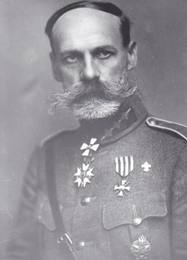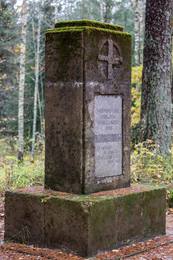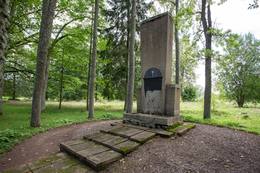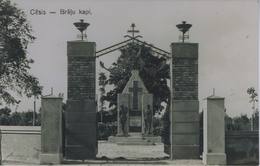Latvian Red Riflemen
I World War I, I Wars of Independence
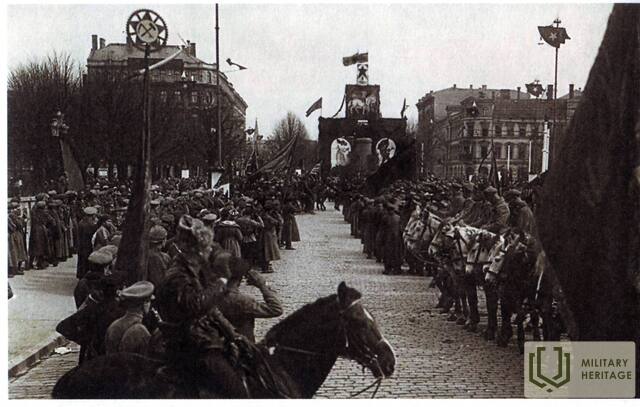
The term "red riflemen" originated during the Russian Civil War in 1918, linking Latvian rifle units with the "Red Guards", the Russian "Red Army", and the generalized term "reds", which was applied to supporters of the Bolsheviks (later communists).
With the outbreak of World War I, the territory of Latvia was gradually occupied by German troops, and a large refugee movement began. The Russian army suffered heavy defeats in the summer of 1915, and Courland, Zemgale, and part of Sēlija fell under German occupation. The Latvian initiative to form national units was one of the few straws that the Russian army, haunted by its failures, could cling to. On August 10, 1915, the press published an appeal to the Latvian people to form national military units, written by writers K. Skalbe and A. Ķeniņš and signed by Russian State Duma deputies Jānis Goldmanis and Jānis Zālītis. In total, about 8,000 volunteers applied, and throughout the course of World War I, there were up to 25,000 men in Latvian rifle battalions.
In 1917, the ideas of Bolshevism spread rapidly among Latvians, who had been driven to despair by the war. The Bolshevists' slogans of peace, land and bread were very popular in war-weary Latvian society. The influence of Bolshevists also grew among the riflemen, who had suffered senseless and heavy losses in the previous winter battles.
In the autumn of 1917, taking advantage of the decline in the fighting capabilities of the Russian army, the Germans occupied Riga, and in February 1918 the entire Vidzeme and Latgale. A large part of the riflemen surrendered to the Germans or simply deserted from their units to remain in Vidzeme. The nobles and the most loyal part of the riflemen fled to Russia. On April 13, 1918, the Latvian Riflemen Soviet Division was formed in Moscow.
Latvian Red Riflemen units were used to protect the Russian Soviet government and high-ranking officials, foreign embassies, maintain order in Russia's largest cities, suppress peasant and worker uprisings, and fight against the Bolsheviks' political opponents during the Russian Civil War from 1918 to 1920.
With the conclusion of the peace treaty between Russia and Latvia, 11,395 former "red" Latvian riflemen returned from Soviet Russia in the summer of 1921. Some of the commanding staff remained in Soviet Russia and built successful military careers. Most of the former riflemen were killed as a result of Stalin's great repressions of 1937-1938.
More information sources
1. Blizzard of Souls. Digital Museum. Available: https://www.dveseluputenis.lv/lv/laika-skala/notikums/93/1917.-gads--latvijas-neatkaribas-cela-sakums/, https://www.dveseluputenis.lv/lv/laika-skala/notikums/128/strelnieki-atgriezas-majup-no-krievijas/ [accessed: 08.05.2021.].
2. Šiliņš J. "Latvian Red Riflemen". National Encyclopedia. Available: https://enciklopedija.lv/skirklis/36374-latviešu-sarkanie-strēlnieki [accessed 08.05.2021.].
3. Vējiņš J. Latvia - in the course of fate 1918 - 1991, Press House, 2007.
Related timeline
Related objects
Latvian Riflemen Monument in Riga
Located in the center of Riga, on Latvian Riflemen Square near the Latvian Occupation Museum.
The monument to the Latvian Riflemen was unveiled in 1971 in Latvian Riflemen Square next to the former Latvian Red Riflemen Museum (now the Museum of Occupation). During the Soviet era, the topic was viewed through the narrow ideological prism of the communist regime. The place served to represent Riga and create an idealized story, reinforcing the myth of Latvians as fighters for Soviet power.
Light infantry units in the Russian army were called riflemen. During World War I, Latvian rifle formations were created to fight against the German army in the homeland. They were motivated, dangerous and disciplined combat units. The high level of education and knowledge of the German language were useful for reconnaissance and conducting surprise attacks. With the collapse of the Russian Empire and the complete occupation of Latvian territory by Germany, a very large number of Latvian residents ended up in Russia, where they continued to face Bolshevik agitation. Initially, support for Lenin's ideas and participation in the Russian Civil War grew. Later, disillusionment followed, and most Latvian soldiers turned away from leftist ideas and returned to Latvia. Most of the soldiers who remained in Russia were killed during the "Stalin purges" (1936-1938). Latvian riflemen made great contributions to the creation of the Latvian state and its army.
Today, you can visit the monument and the adjacent Occupation Museum.
General Karls Goppers Memorial Room in his birthplace "Maskati"
Located in Plāņi parish on the banks of the Vija River.
The memorial room of General Kārlis Goppers in his birthplace "Maskati" can be visited.
The “Maskatu” farm was run by the general’s brother Augusts Goppers, because the talented war leader was busy with major events and world wars. In 1920, the general returned to Latvia, to his native home. But many responsible duties connected him to Riga. Augusts continued to manage “Maskatu”. In 1940, General Goppers was arrested and shot in the Cheka cellars on March 25, 1941. In 1944, the Gopper family fled to Courland with three horse-drawn carriages. The war divided the family, and Aleksandrs Goppers’ daughters – Biruta, Elza and Anna – remained in Latvia. They were no longer allowed to return to “Maskatu”. The houses were large and carefully maintained. Three or four families of newcomers were accommodated there in separate rooms. A horse farm was set up in the large barn. Due to mutual quarrels, a fire broke out in 1980. The barn and the large shed burned down. Fortunately, the fire did not spread to the house, the flames were repelled by large trees planted by our ancestors.
In 1991, after the miraculous Awakening, the Latvian state was reborn for the second time. In 1992, the family of General Goppers' brother August regained “Maskatus” as a sacred place of their ancestors. For ten years, everyone worked hard to save the houses from destruction, to restore and rebuild the destroyed buildings, to make the entire “Maskatus” farm beautiful. The houses have been restored to their ancient appearance, and a memorial room for General Kārlis Goppers has also been set up. The memorial room can be visited by calling in advance and making an appointment at +371 29396870, +371 29254285.
Excursion to the monument to the soldiers who fell in World War I in the Spāre Manor Park
Located in the territory of the Spāre Manor complex.
During World War I, the Spāre Manor housed a field hospital for the Russian army. The 24 soldiers who died there, including Latvian riflemen, are buried in the nearby fraternal cemetery. The monument was unveiled on October 6, 1935.
When establishing the memorial site (starting from the road), rows of linden trees were planted on both sides of the road. In 1935, all the improvement work in the area was carried out by Spāre students under the leadership of the school principal Kārlis and Alvīne Skalbergs.
Students from the Spāre Primary School in Amata Municipality are also currently involved in cleaning up the memorial site. The Cēsis 27th KB National Guards provide great support in these works.
A torchlight procession to the memorial site for those who fell in World War I has become a tradition, which is organized on November 11. This event is always led by the Cēsis 27th KB National Guards, and they are always accompanied by a chaplain. An indispensable part of the event is the celebratory volley.
An excursion to the monument to the soldiers who fell in World War I (45 min.) is offered in the territory of the Spāre Manor complex, by booking a visit in advance by calling +371 26558464.
Monument to the soldiers who fell in World War I and the Latvian War of Independence
Located on Church Street opposite St. Anne's Church.
A monument to the soldiers who fell in World War I and the Latvian War of Independence can be seen.
On May 1, 1923, a “Heroes’ Grove” was planted opposite the Mazsalaca Lutheran Church, in which an oak tree was dedicated to each fallen soldier. According to Likert, a total of 97 oak trees were planted – 23 to those who fell in the War of Independence and 74 to those who fell in World War I. However, the press of the time mentioned that 106 oak trees were planted.
On August 21, 1927, a concrete monument designed by architect Pauls Kundziņš was unveiled in the “Heroes' Grove”, with sculptor Vilhelms Treijs also participating in its construction.
The monument is located next to the Church of St. Anne in Mazsalaca, which was built in a specially selected location so that its slender (58.6 m), beautiful tower could be seen from afar. The church is well preserved, as it was neither destroyed nor adapted for any other purposes during the Soviet era.
Cēsis Brothers' Cemetery
Located in the Cēsis Lower Cemetery, Lenču Street 15, Cēsis.
One of the most significant memorial sites of the First World War and the War of Independence in Cēsis is the Brothers' Cemetery in Lejas Kapis.
The cemetery houses the Brothers' Cemetery Monument, designed by Cēsis artist and councilor Augusts Julla (1872-1958), unveiled in 1927, and dedicated to the soldiers buried in the Brothers' Cemetery from 1915 to 1920.
About 200 soldiers are buried in the Brothers' Graves of the Cēsis Leja Cemetery. Among them are an unknown number of Latvian riflemen and Russian soldiers who fell in World War I, as well as soldiers of German (10), Polish and other nationalities. During the Latvian Liberation Struggles, 22 soldiers of the 5th (2nd) Cēsis Infantry Regiment were buried in this cemetery, as well as 11 freedom fighters who fell in other Latvian army units. 2 Estonians, 15 victims of the Bolsheviks, and Latvian Red Riflemen also rest in the Brothers' Graves.
Krači Mountains Monument
The Krāči Hills are one of the largest coastal dunes of the Litorina Sea. Its highest point is 29 m above sea level and 26 m above the surrounding plains. The Litorina Sea is said to be the predecessor of the Baltic Sea, which existed approximately 7,000 to 5,000 years ago.
The 6th Special Brigade of the 12th Russian Army launched the attack from the Krāči Hills during the Christmas Battles, with the task of breaking through the German front from the Great Tīreļi Swamp to the Lielupe River. During the month-long battles, the Russian army gained an area of 25 square kilometers, but the losses were enormous – 45 thousand fallen, wounded and missing soldiers. The losses of the Latvian riflemen were 9 thousand fallen, wounded and missing soldiers. During the Christmas Battles, the Latvian riflemen gained immense fame as heroic and brilliant soldiers, paying a very high price for it – their lives.
A monument has been erected in memory of those who fell in battle. Every year on November 11, Lāčplēsis Day, and on November 18, the anniversary of the proclamation of the Latvian state, candles are lit at this place in memory of the fallen heroes.
The protected nature area "Krāči Mountains" as a dune mound of the Litorina period
Related stories
Anšlavs Eglītis's memories of the Latvian War of Independence and the events of 1919 in Alūksne
On March 27, 1919, the 1st Valmiera Infantry Regiment, together with the Estonian Guards (kaitselit) battalions of Tallinn (then Rēvele) and Tērbatas, as well as three armored trains, began the liberation of Latvia from the Bolsheviks from the banks of the Melnupe River.
About General Karlis Goppers
General K. Goppers (1876-1941) was an outstanding soldier and an outstanding person. He distinguished himself as a successful commander who took command of battalions and regiments, heroically leading his riflemen in battles for the freedom of Latvia during the First World War (1914-1919). He participated in the battles at Tīreļpurva, Ložmetējkalns, and in the defense of Riga.
Memories of the beginning of the creation of the War Museum
The narrator describes the circumstances under which the War Museum was established. The problems and the work of creating collections are mentioned.
Saving the bridge over the Nega River from being blown up
During the German retreat in 1944, many important objects were blown up and it was very difficult to prevent this, however, there are also stories about miraculous incidents when the courage of local residents and the tolerance of a soldier allow places that are important to the locals to be saved, and the salmon survived. One of the stories is this one about a discussion between a housewife and a German soldier that saved an entire bridge from being blown up.







